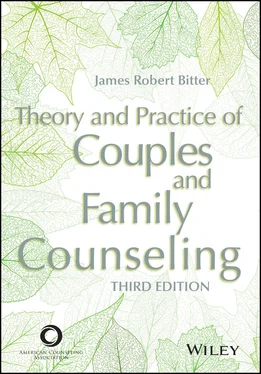James Robert Bitter - Theory and Practice of Couples and Family Counseling
Здесь есть возможность читать онлайн «James Robert Bitter - Theory and Practice of Couples and Family Counseling» — ознакомительный отрывок электронной книги совершенно бесплатно, а после прочтения отрывка купить полную версию. В некоторых случаях можно слушать аудио, скачать через торрент в формате fb2 и присутствует краткое содержание. Жанр: unrecognised, на английском языке. Описание произведения, (предисловие) а так же отзывы посетителей доступны на портале библиотеки ЛибКат.
- Название:Theory and Practice of Couples and Family Counseling
- Автор:
- Жанр:
- Год:неизвестен
- ISBN:нет данных
- Рейтинг книги:5 / 5. Голосов: 1
-
Избранное:Добавить в избранное
- Отзывы:
-
Ваша оценка:
- 100
- 1
- 2
- 3
- 4
- 5
Theory and Practice of Couples and Family Counseling: краткое содержание, описание и аннотация
Предлагаем к чтению аннотацию, описание, краткое содержание или предисловие (зависит от того, что написал сам автор книги «Theory and Practice of Couples and Family Counseling»). Если вы не нашли необходимую информацию о книге — напишите в комментариях, мы постараемся отыскать её.
Theory and Practice of Couples and Family Counseling — читать онлайн ознакомительный отрывок
Ниже представлен текст книги, разбитый по страницам. Система сохранения места последней прочитанной страницы, позволяет с удобством читать онлайн бесплатно книгу «Theory and Practice of Couples and Family Counseling», без необходимости каждый раз заново искать на чём Вы остановились. Поставьте закладку, и сможете в любой момент перейти на страницу, на которой закончили чтение.
Интервал:
Закладка:
Jane met Paul in 1983. She was completing her degree in psychology and taking a graduate course in psychopathology as part of her undergraduate degree. Paul had finished his undergraduate work in premed in only 3 years: He was 20 years old and started in medical school immediately. Paul saw Jane across the room in the university library, and it was all over for him. He walked up to Jane, introduced himself, and asked her whether she would like to get a cup of coffee with him, and they were a couple from that point on.
They married 2 years later, and their first child was born on schedule as Paul finished his first residency in internal medicine. She was named Amy after Jane’s mother and at Paul’s suggestion. There was very little conflict between Paul and Jane—nothing that anyone really would notice. They were very happy with Amy: She was healthy, interested in others, kind, and intelligent. Two years later, Ann was born, and now Paul and Jane had two beautiful daughters. Except for some relatively early childhood bickering, the two girls settled into sisterhood and even seemed to like each other and get along.
When Amy and Ann reached their teenage years, both were gone a lot with various activities. With Amy driving, Jane did not see the girls as much as she had when she was chauffeuring them around town. It seemed as though the empty nest had arrived early for her, and Jane decided to do volunteer work at a woman’s shelter. It was there that she met a young woman from Guatemala with two small boys.
The boys were named Jason and Luke, because they were light skinned and the mother wanted to pass them off as White. They were 4 and 2 years old, respectively, when Jane first met them. They had been terribly abused by their father: They had been burned with cigarettes, had broom straw pushed under their nails, and been hit in the head and spanked mercilessly. Their mother too had been abused, and there was a court order to deport the father. Shortly after Jane met them, the mother disappeared, leaving a note that asked Jane to look after her boys. The mother was found dead a few weeks later. By that time, Jane had taken the boys in as foster children. After the mother’s death, Paul and Jane started the process of adoption, which took a little over a year.
Jane had hoped that love would make the difference in the boys’ lives, but they were 20 times more difficult than her daughters had ever been. They liked to hurt things and each other. They fought physically, kicking, biting, and hitting all the time. They beat the neighbor’s dog with a stick. They stole within the family and without—food, money, and clothes—and recently Jane had stopped Jason from setting Luke on fire. She always felt in conflict with them. Paul too felt the change in the house, and to Jane he seemed to withdraw further into his work. Amy was heavily involved in the last of her high school days and was dating a young man she would stop seeing when she went to college. Only Ann was available to help her mother with the boys. She cut back on her activities at school and after school. She did the best she could, but the boys never listened to her.
Quest Family Genogram
At the time of counseling, Paul is 45, Jane is 43, and Amy and Ann are 18 and 16, respectively. The two boys, Jason and Luke, are 6 and 4. A genogram of the Quest family appears below. A genogram is a family map that indicates both the structure and emotional relationships of a family and its members. We will take a closer look at genograms in the chapter on Bowen’s multigenerational family theory. For a complete guide to genograms, see McGoldrick et al. (2020).
In all of the theory chapters that follow, you can assume that the practitioners have access to this background information on the Quest family. Each practitioner will apply the theory and interventions of the model as they would be adapted to the Quest family. You may find it useful from time to time to refer back to the family data and genogram as you note how each theory addresses various aspects of the case.
I realize that a lot of information is contained in the story of the Quest family. This amount of information is uncommon in therapeutic practice. It constitutes the raw data that will be the foundation for the qualitative analysis and action research that will inform future therapeutic practice in the field of family counseling. How each model chooses to sort through the data, identify significant themes, and decide on therapeutic interventions says something about both the model and its practitioners. As you sort through the information contained in the story of the Quest family, what themes stand out to you? How do you prioritize the themes you identify? How would you verify that the themes you have identified as significant are also important to the family? In what ways does identifying themes, sequences, and processes inform your understanding of the family? Are you aware that just answering these questions engages you in qualitative research (Dahl & Boss, 2005; Echevarria-Doan & Tubbs, 2005)? When your understanding is translated into interventions and you assess the effectiveness of those interventions, you are also engaged in action research (Mendenhall & Doherty, 2005). Like all areas of the helping professions, evidence-based practice is essential to the future development of family counseling.

Note
1 1 I also recommend that you attend a convention or workshop at which a great master who interests you is presenting. The Evolution of Psychotherapy conferences are some of the best. They are held once every 4 or 5 years and are sponsored by the Milton H. Erickson Foundation. The most recent one was held in December 2017, and the next one is currently scheduled for December 2020. You can find more information about these conferences at www.erickson-foundation.org.
Конец ознакомительного фрагмента.
Текст предоставлен ООО «ЛитРес».
Прочитайте эту книгу целиком, на ЛитРес.
Безопасно оплатить книгу можно банковской картой Visa, MasterCard, Maestro, со счета мобильного телефона, с платежного терминала, в салоне МТС или Связной, через PayPal, WebMoney, Яндекс.Деньги, QIWI Кошелек, бонусными картами или другим удобным Вам способом.
Интервал:
Закладка:
Похожие книги на «Theory and Practice of Couples and Family Counseling»
Представляем Вашему вниманию похожие книги на «Theory and Practice of Couples and Family Counseling» списком для выбора. Мы отобрали схожую по названию и смыслу литературу в надежде предоставить читателям больше вариантов отыскать новые, интересные, ещё непрочитанные произведения.
Обсуждение, отзывы о книге «Theory and Practice of Couples and Family Counseling» и просто собственные мнения читателей. Оставьте ваши комментарии, напишите, что Вы думаете о произведении, его смысле или главных героях. Укажите что конкретно понравилось, а что нет, и почему Вы так считаете.












